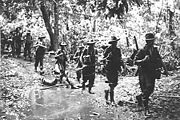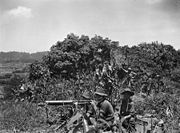
Jungle Division
Encyclopedia

Australian Army
The Australian Army is Australia's military land force. It is part of the Australian Defence Force along with the Royal Australian Navy and the Royal Australian Air Force. While the Chief of Defence commands the Australian Defence Force , the Army is commanded by the Chief of Army...
during the Second World War
World War II
World War II, or the Second World War , was a global conflict lasting from 1939 to 1945, involving most of the world's nations—including all of the great powers—eventually forming two opposing military alliances: the Allies and the Axis...
. This organisation was a much lighter version of the standard British-pattern infantry division
Division (military)
A division is a large military unit or formation usually consisting of between 10,000 and 20,000 soldiers. In most armies, a division is composed of several regiments or brigades, and in turn several divisions typically make up a corps...
used during previous campaigns in the deserts of North Africa and was optimised to meet the needs of jungle warfare
Jungle warfare
Jungle warfare is a term used to cover the special techniques needed for military units to survive and fight in jungle terrain.It has been the topic of extensive study by military strategists, and was an important part of the planning for both sides in many conflicts, including World War II and the...
against the Japan
Japan
Japan is an island nation in East Asia. Located in the Pacific Ocean, it lies to the east of the Sea of Japan, China, North Korea, South Korea and Russia, stretching from the Sea of Okhotsk in the north to the East China Sea and Taiwan in the south...
ese in the South West Pacific Area
South West Pacific Area
South West Pacific Area was the name given to the Allied supreme military command in the South West Pacific Theatre of World War II. It was one of four major Allied commands in the Pacific theatres of World War II, during 1942–45...
. Jungle divisions were smaller and had fewer heavy weapons, vehicles and support units and despite some modifications, this re-organisation proved quite successful during later Australian operations in New Guinea
New Guinea campaign
The New Guinea campaign was one of the major military campaigns of World War II.Before the war, the island of New Guinea was split between:...
, New Britain, Bougainville, Aitape-Wewak
Aitape-Wewak campaign
The Aitape–Wewak campaign was one of the final campaigns of the Pacific Theatre of World War II. Between November 1944 and the end of the war in August 1945, the Australian 6th Division, with air and naval support, fought the Imperial Japanese 18th Army in northern New Guinea...
and Borneo
Borneo campaign (1945)
The Borneo Campaign of 1945 was the last major Allied campaign in the South West Pacific Area, during World War II. In a series of amphibious assaults between 1 May and 21 July, the Australian I Corps, under General Leslie Morshead, attacked Japanese forces occupying the island. Allied naval and...
.
Reorganisation of the Australian Army, 1943
.jpg)
Australian 1st Armoured Division
The Australian 1st Armoured Division was raised in 1941 as part of the Second Australian Imperial Force . While the Division was originally to be deployed to North Africa in late 1941, it was retained in Australia following the outbreak of the Pacific War...
was formed. The two Citizens Military Force
Australian Army Reserve
The Australian Army Reserve is a collective name given to the reserve units of the Australian Army. Since the Federation of Australia in 1901, the reserve military force has been known by many names, including the Citizens Forces, the Citizen Military Forces, the Militia and, unofficially, the...
cavalry divisions were first motorised and then converted into armoured divisions in 1942 and the 3rd Army Tank Brigade was formed to provide support to the infantry. However in response to the growing Japanese threat Australian forces were concentrated in the Pacific, and in response to this changing operational environment land headquarters identified the need for three different types of division in February 1943: armoured divisions, standard infantry divisions and jungle infantry divisions. Large armoured units were especially not suitable for jungle warfare, and most were disbanded during 1943 and 1944.
Ultimately the conditions that prevailed in the South West Pacific led the Australian Army to convert six infantry divisions to 'Jungle divisions' in early 1943. This organisation operated on reduced manpower and had fewer heavy weapons, vehicles and support units then the British-pattern division previously used, with the main imperatives being "manpower, transport, and communications." Specifically each battalion
Battalion
A battalion is a military unit of around 300–1,200 soldiers usually consisting of between two and seven companies and typically commanded by either a Lieutenant Colonel or a Colonel...
was reduced in size and placed on a new ‘tropical war establishment’, the anti-aircraft and carrier platoons were disbanded, and the later converted into a medium machine gun platoon of four Vickers machine gun
Vickers machine gun
Not to be confused with the Vickers light machine gunThe Vickers machine gun or Vickers gun is a name primarily used to refer to the water-cooled .303 inch machine gun produced by Vickers Limited, originally for the British Army...
s, while the number of 3-inch mortars
Ordnance ML 3 inch Mortar
The Ordnance ML 3-inch mortar was the United Kingdom's standard mortar used by the British Army from the late 1920s to the late 1960s, superseding the Stokes Mortar.-History:...
was increased from six to eight. Equally while the standard division contained a large number of motorbikes, trucks and mechanised vehicles, such transport was of limited use in the rugged, roadless jungles and the muddy tracks of the South West Pacific. To this end each rifle company
Company (military unit)
A company is a military unit, typically consisting of 80–225 soldiers and usually commanded by a Captain, Major or Commandant. Most companies are formed of three to five platoons although the exact number may vary by country, unit type, and structure...
in a jungle division was restricted to just one jeep and trailer, relying instead on ‘foot mobility’ and supported logistically by native carrier trains rather than vehicles, as well as by air transport and supply dropping.The establishment of a standard infantry battalion was 35 officers and 875 other ranks. Under the jungle organisation each battalion was reduced by 1 officer and 106 other ranks. As many administrative personal as possible were also removed from the divisional structure, while fewer vehicles also meant a reduced requirement for maintenance personnel and reduced logistical support.
.jpg)
Six infantry divisions were eventually converted to the jungle organisation including three CMF militia divisions: the 3rd, 5th and 11th
11th Division (Australia)
The 11th Division was an Australian Army unit formed during World War II by the redesignation of Milne Force on 1 October 1942. The division saw action in New Britain...
and the three Australian Imperial Force divisions: the 6th
Australian 6th Division
The 6th Division of the Australian Army was a unit in the Second Australian Imperial Force during World War II. It served in the North African campaign, the Greek campaign and the New Guinea campaign, including the crucial battles of the Kokoda Track, among others...
, 7th
Australian 7th Division
The 7th Division was an infantry division of the Australian Army. It was formed in February 1940 to serve in World War II, as part of the Second Australian Imperial Force...
, 9th
Australian 9th Division
The 9th Division was a division of the Australian Army that served during World War II. It was the fourth division of the Second Australian Imperial Force and was formed in the United Kingdom in late 1940 from infantry brigades and support units which had been previously raised in Australia and...
. These divisions formed the bulk of Australia’s deployed forces, with the remaining divisions predominantly used for home service where the open terrain suited them, while others were disbanded.The 10th Division
Australian 10th Division
The 10th Division was a division of the Australian Army, which served briefly during World War II. It was initially formed on 15 April 1942 from the Militia units of the Newcastle Covering Force, however, manpower shortages within the Army at that time led to it being disbanded in August that year...
had been disbanded in 1942; the 1st Armoured
Australian 1st Armoured Division
The Australian 1st Armoured Division was raised in 1941 as part of the Second Australian Imperial Force . While the Division was originally to be deployed to North Africa in late 1941, it was retained in Australia following the outbreak of the Pacific War...
, 2nd Armoured
Australian 2nd Armoured Division
The Australian 2nd Armoured Division was established on 21 February 1942 by redesignating and reorganising the 2nd Motor Division . As an armoured division the division was equipped with M3 Grant medium tanks and M3 Stuart light tanks...
and 3rd Armoured Division
Australian 3rd Armoured Division
The Australian 3rd Armoured Division was an armoured unit of the Australian Army that was established on 15 November 1942 by redesignating the 1st Motor Division . As an armoured division the 3rd Armoured was equipped with M3 Grant medium tanks and M3 Stuart light tanks...
s were disbanded in 1943. The 2nd and 4th Divisions were disbanded in 1944. The 1st Division
1st Division (Australia)
The 1st Division is the main formation of the Australian Army and contains the majority of the army's regular forces. Its headquarters is in Enoggera, a suburb of Brisbane...
(a training formation) and the 12th Division (Northern Territory Force) were reduced to one brigade each in 1945. Although the jungle divisions proved successful experience later indicated that additional artillery support was required and a number of divisions—including the 7th and 9th—were subsequently assigned an additional two field artillery regiments. Regardless, although the jungle divisions had less firepower than the standard division they were better suited for the projection of power in the tropics.
Order of battle

Corps
A corps is either a large formation, or an administrative grouping of troops within an armed force with a common function such as Artillery or Signals representing an arm of service...
level, and were assigned to divisions as required.
- Divisional Headquarters
- 3 Infantry Brigades (each of three Infantry Battalions for a total of nine)
- 1 Field Artillery Regiment (equipped with twenty-four 25 Pounder guns)
- 1 Light Anti-Aircraft Battery
- Divisional Provost Company (Military PoliceMilitary policeMilitary police are police organisations connected with, or part of, the military of a state. The word can have different meanings in different countries, and may refer to:...
) - Divisional Carrier Company (equipped with Bren Carriers)
- Divisional Signals
- Divisional Engineers
- 1 Field Park Company
- 3 Field Companies
- Camouflage Training Unit
- Divisional Supply and Transport
- Supply Depot Company
- General Transport Company
- 3 Field Ambulance Companies
- 6 Light Aid Detachments
- 3 Brigade workshops

